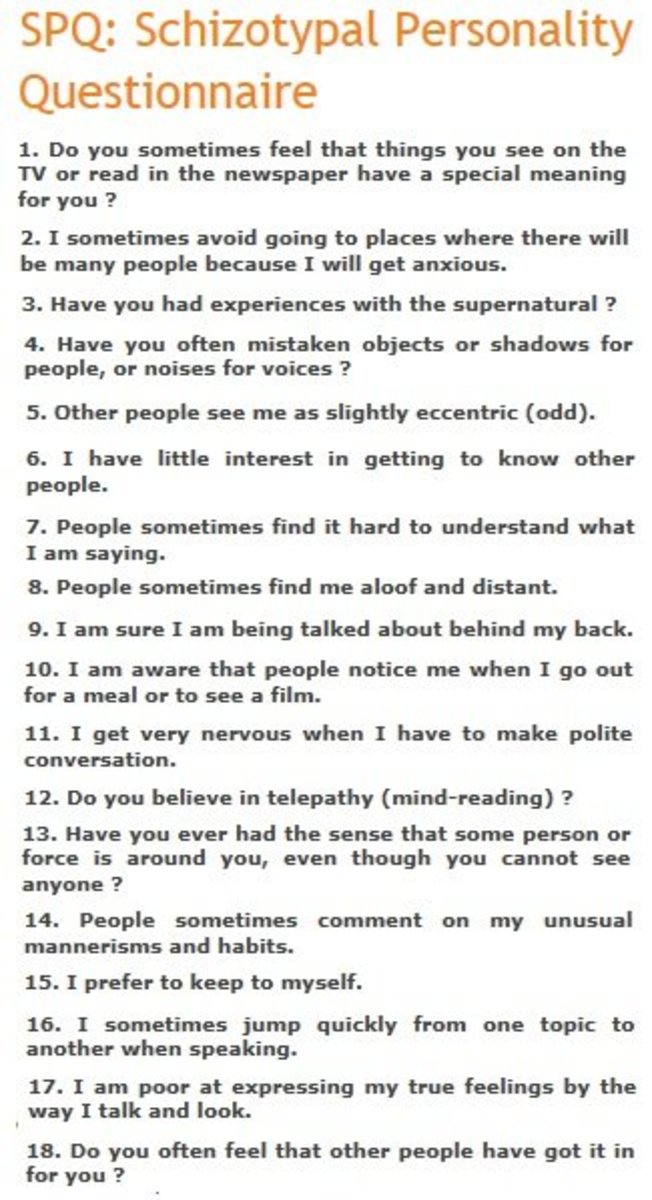Important Psychiatric Disorders: Personality Disorders I Have Known In Private Practice and Adjunct Therapy

Introduction and the DSM-V
In Spring 2013 came the release of the fifth edition of the diagnostic manual of the American Psychiatric Association, called the DSM-V. It replaced the DSM-IV-TR and included changes for a number of psychiatric conditions and added additional mental health disorders to its contents and description classifications.
This Hub will does mention the names, locations, or dates of contact with the following examples of Personality Disorders that were diagnosed under the DSM-IV-TR by competent, licensed psychiatrists. These cases were referred to a range of facilities in which I worked in the services of 1) medication reduction or withdrawal, 2) pain and stress management, 3) Workers Compensation Rehabilitation programs, 4) support group activities, 5) relaxation and talking therapies, and 6) exercise classes, and others. In fact, the persons in these examples are now deceased.
An upsurge has occurred in the discussion of mental health diagnoses and treatments among the general population during the 2010s. With the advent of the DSM-V and changed criteria for diagnoses, it is easier than ever for untrained lay diagnoses to be incorrect and harmful. If concerned or interested in your own or others' behaviors that may be unhealthy, please see some effective, legal, and ethical steps to take in my article How to Questions a Doctor's Diagnosis. Professional intervention is more important than ever.
To our confounding, many mental health conditions overlap in symptoms. There is a protocol for determining which symptoms take priority for diagnosis that must legally be followed, but the general public do not usually have access to these..
Reaching a definitive diagnosis requires interviews, personal and family behavioral and medical histories, observations, psychiatric testing, and soon, even DNA analysis in some upcoming cases. The total process is much more complex than some understand it to be. See the required steps at How to Do A Mental Health Assessment.

Aggressive Personality Disorder - Questionable
In the late 1980s, during the use of the DSM III-R, I was presented with a case for evaluation of a 5-year-old male with an accompanying report (sketchy) that listed a diagnosis of only "Aggressive Personality Disorder", but no mention of Axis designations. This was confusing and not standard practice. Additionally, at the time, diagnosis of children with adult mental health disorders was not encouraged. Having never heard of this particular personality disorder, I found that it was not listed in the DSM-III-R, or Diagnostic and Statistical Manual, version III-Revised, of the American Psychiatric Association. This was interesting.
The child might have been diagnosed ADHD, because as soon as he entered the room, he ran around the floor in a circle and three steps up the wall -- Perhaps he had been watching Fred Astaire movies.
He also brought with him a history of climbing into extremely high places, unless strictly controlled by his parents. This included railings on the back of the highest bleachers in gymnasiums, tall trees in state recreational areas, roofs, pieces of construction machinery parked near his home, and other examples. Luckily, I was not looking for a new diagnosis, but only evaluating the child for which adjunct physical activities might channel energy in a postive way. Rock climbing and wall climbing were perfect. His parents chose soccer, judo, and karate.
Before losing touch with this nuclear family of two parents and one child, I eventually discovered some interesting background. Firstly, in general, each relocation of home in early childhood and into the early elementary school years tends to produce a regression of maturity of a full year. The child in this case experienced three moves already by age 5 years, 6 months.
The son was also left at home alone on workdays from 3:00PM - 5:00PM after the preschool bus brought him home. At age 5 years, this is illegal treatment as well as inappropriate. The child reported that he was also always hungry and was not always fed every day, and this information was passed through proper channels.
Eventually, the appropriate care systems discovered that the child had been placed on a "point system" from birth. He was to be quiet for a certain number of minutes and exhibit other required behaviors for specific time intervals in order to earn 1) being picked up, 2) being talked to, 3) being fed, and other "rewards." I was stunned at the report.
IMPACT OF THE INFORMATION: CAUSES
A team of two psychiatrists that specialize in brain mapping and whom I admire have satisfied themselves that personality disorders and some other mental health conditions form within the first three months of life after birth, through the interference with the psychoneurological development of the infant by psychologically unhealthy individuals in the environment of the child. From my own experiences in a private practice, counseling, education, and adjunct therapy, I find myself agreeing.
I cannot find a disorder called "Agressive Personality Disorder", but one called Passive-Aggressive Personality Disorder does exist. I do not see that the latter diagnosis fits the child above, but I did not participate in the full psychological diagnosis and I do not think one was completed.


Borderline Personality Disorder (BPD)
A segment of mental health professionals tell us that all teenagers possess Borderline Personality Disorder (BPD), yet should not be so diagnosed. They feel that chronological maturity brings the youth out of the symptom sets associated with BPD. These practitioners feel that the BPD symptom sets "come with the territory" of the teenage years.
At the same time, increasing numbers of teens are receiving adult mental diagnoses in the 2010s and this is disturbing. This information will go into a national medical database forever, once that system initiates. The database may unfortunately function almost like a criminal system in these cases, because of the stigma still attached to psychiatric diagnoses in our culture. The stigma gives rise to prejudices and assumptions that may be incorrect. This may also put into place a sort of "type casting" in which an individual wears a label and is administered treatments long-term that are not entirely effective.
A SPECIFIC CASE
A war veteran was diagnosed in the1980s with "a cyclical mood disorder", Somatoform Disorder (in short, focused on physical problems), and Borderline Personality Disorder (BPD), in addition to physical injuries of war.
In summary, the client did not exhibit enough of the symptoms of BPD to justify that diagnosis. The cyclical diagnosis was dropped, but BPD was retained. Thus, he reportedly possessed BPD, Somatoform Disorder, and physical injuries that included injuries in a military vehicle collision and head and neck cancer from dioxin exposure.
In further interviews, it was found that the client was in the middle of 7 male and female siblings, one of each gender being molested by the male parent. The parents both died and the siblings were separated into different adoptive households. The client, however, suffered long-term physical abuse from the adoptive mother, coincidentally in the same areas injured by the wartime vehicle injury that worsened over time. In fact, the same areas of the body were injured a third time in occupational tasks. Post Traumatic Stress Disorder might have been diagnosed as well, given the PTSD symptoms also present, but the psychiatrist did not consider it.
IMPACT OF INFORMATION
This is a sad case. The few Borderline Personality Disorder symptoms demonstrated by the client probably began with his Family of Origin and were reinforced by 1) adoptive-parent physical abuse, 2) wartime injury at the same anatomical sites, and 3) workplace injuries at the same anatomical sites.
The BPD symptoms present were 1) outsized anger and 2) inability to maintain relationships - Except that he held onto to two close relationships for totals of 25 years and 10 years at his death. One needs 5 symptoms to qualify, as it were, for this personality disorder.
I THINK WE NEED A FIELD OF FORENSIC PSYCHIATRIC DIAGNOSIS
I believe that no one ever read the entire file and interview notes, or connected up the history of injuries to the same anatomical areas three times, or noted the foundation of physical abuse suffered and sexual abuse witnessed early on. Various files were in too many places in too many offices for a reconstruction.
This case history may have led to some BPD symptoms, but it started with child abuse and three severe long-term injuries that reinforced it, all in the same anatomical areas. The client also had a range of heart conditions that can and did manifest as psychological symptoms. I think some practitioners missed that connection in this client as well. He was killed gradually by abuse and injuries, mentally and physically, while he coped (sometimes in odd ways) until he died. This is more than BPD in my view.







